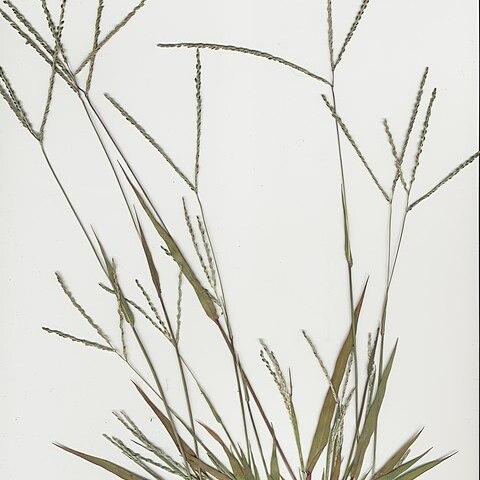Loosely tufted annual, 200-600 mm high. Leaf blade 20-200 x 1-7 mm; ligule an unfringed membrane. Inflorescence in pairs or subdigitate on a short central axis, of 2-6 racemes; rachis triquetrous, broadly winged, glabrous, margins glabrous or scaberulous; pedicels with a corona of short hairs at apex; spikelets abaxial, in clusters of 2 or 3. Spikelets 2.5-2.7 mm long, oblong, dorsiventrally compressed; lower glume reduced to small cuff, obscure; upper glume 3/4 as long as spikelet, 3-nerved, clavate hairs between nerves; internode absent. Florets 2; lower floret sterile, lemma lanceolate, as long as spikelet, not deeply grooved, 5-nerved, covered with white clavate hairs; upper floret bisexual, lemma ± as long as spikelet, light to dark brown or purplish black margins flat and covering most of palea. Flowering time Nov.-May.
Loosely tufted annual 200-600 mm high. Leaf blade 20-200 x 1-7 mm. Inflorescence in pairs or subdigitate on short central axis, of 2-6 racemes 40-200 mm long; rachis triquetrous, broadly winged, glabrous, margin glabrous or scaberulous; pedicels with a corona of short hairs at apex; spikelets in clusters of 2 or 3. Spikelet 1.5-2.7 mm long, oblong, densely hairy, hairs clavate; lower glume reduced to small obscure cuff or absent; upper glume 2/3 as long as spikelet, 3-nerved, clavate hairs between nerves; internode absent; lower lemma as long as spikelet, not deeply grooved, 5-nerved, nerves smooth, hairs clavate-tipped; upper lemma as long as spikelet, dark brown or purplish black; anthers 1.0-1.4 mm long.
Annual; up to 0.6 m high; loosely tufted. Leaf blades 20-200 x 1-7 mm. Flowers: inflorescence digitate or subdigitate on short central axis; midrib winged; racemes in a pair or up to 6; 40200 mm long; spikelets 1.5-2.7 x 0.8 mm; spikelets in clusters of (2 or) 3; pedicels with a corona of short hairs at apex; upper glume 3/4 as long as spikelet; upper glume and lower lemma covered with white clavate hairs; upper female-fertile floret dark brown or purplish black.
Annual, loosely tufted, up to 0.6 m high. Leaf blades 20-200 mm long, 1-7 mm wide. Spikelets 1.5-2.3 mm long, 0.8 mm wide. Racemes 40-200 mm long, 2-6, in pairs or subdigitate on short central axis, midrib winged; spikelets in clusters of (2 or) 3; pedicels with a corona of short hairs at apex; upper glume three-quarters as long as spikelet; upper glume and lower lemma covered with white clavate hairs; female-fertile (upper) floret dark brown or purplish black.
A wild millet grass. It is a tufted annual grass. It grows 1.5 m high. The leaves are narrow and flat. The stems have 3 or 4 seed racemes extending sideways and 15 cm long. The seed are 2 mm long. They are dark coloured.

